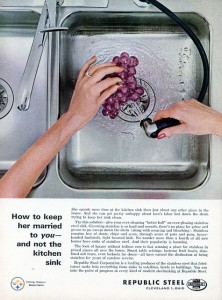They May Look Like the 20th Century, But They Talk Like Today
Posted on June 19, 2012 at 8:45 am

 The producers of “Mad Men” and “Downton Abbey” are justifiably lauded for their meticulous attention to period detail in the clothes, furnishings, and world events of the eras they portray. And audiences love seeing the styles of 1960’s New York and early 20th century England. But there is one area where it would be too difficult for the writers and too jarring for the audience to be true to the period, and that is the language. While they may avoid obvious modern expressions like the use of “okay” in “Snow White and the Huntsman,” an alert grad student has documented the anachronisms in these shows and elsewhere and it makes for an entertaining and most illuminating interview on Slate’s “Lexicon Valley” podcast. What year did we start using the term “put him on hold?” When did we first use the word “wartime?” Did we say “more traditional” in eras where traditions had not changed much in decades? And what two-word phrase you need to use nearly every day was hardly ever used until the 1970’s — and what does its rise as the prior phrase fell out of use tell us about the way we view ourselves?
The producers of “Mad Men” and “Downton Abbey” are justifiably lauded for their meticulous attention to period detail in the clothes, furnishings, and world events of the eras they portray. And audiences love seeing the styles of 1960’s New York and early 20th century England. But there is one area where it would be too difficult for the writers and too jarring for the audience to be true to the period, and that is the language. While they may avoid obvious modern expressions like the use of “okay” in “Snow White and the Huntsman,” an alert grad student has documented the anachronisms in these shows and elsewhere and it makes for an entertaining and most illuminating interview on Slate’s “Lexicon Valley” podcast. What year did we start using the term “put him on hold?” When did we first use the word “wartime?” Did we say “more traditional” in eras where traditions had not changed much in decades? And what two-word phrase you need to use nearly every day was hardly ever used until the 1970’s — and what does its rise as the prior phrase fell out of use tell us about the way we view ourselves?


